Platy Fish Tank Setup
The first thing you need to do when setting up a platyfish tank is to decide on the size and dimensions of the aquarium. Platy fish are relatively small, so you don’t need a huge tank. A 20-gallon tank is plenty of space for a small group of platies.
If you’re planning on keeping a large number of platies, or if you want to add other fish to the tank, you’ll need a larger aquarium. A 30 or 40-gallon tank would be a good choice for a mixed-community aquarium.
When choosing the dimensions of your tank, keep in mind that platies are active swimmers, and they prefer a tank that is longer than it is tall. A taller tank will give your platies more vertical space to swim and explore.
Filtration
Platies are relatively tolerant of different water conditions, but they do best in a clean and well-filtered aquarium. A good filtration system will help to keep the water quality high and will also help to prevent ammonia and nitrite build-up in the tank.
Platies are not overly sensitive to nitrate levels, but a high nitrate level can contribute to algae growth. For this reason, it’s a good idea to choose a filter that has good nitrate removal capabilities.
There are a variety of different types of filters available on the market, so it’s important to do your research and choose the best filter for your platy fish tank.
Substrate
The substrate you choose for your platy fish tank is mostly a matter of personal preference. Gravel is the most popular choice, but sand can also be used. Just make sure that the substrate you choose is not too large or sharp, as platies are small fish and they can easily swallow gravel that is too big.
Plants
Platies are not overly finicky when it comes to plants, but they do prefer a tank with some vegetation. Live plants are always the best choice, as they will help to oxygenate the water and provide hiding places for your plants.
Some good plant choices for a platy fish tank include duckweed, hornwort, anacharis, and java fern. These plants are all relatively easy to care for and they will do well in a wide range of water conditions.
Lighting
Platies do not require special lighting, but they do prefer a well-lit tank. A basic fluorescent aquarium light will be sufficient for most platy fish tanks. If you are keeping live plants in the tank, you may need to upgrade to a stronger light to support the plants’ growth.
Water Conditions
Platies are relatively tolerant of different water conditions, but they do best in slightly basic water. A pH level of 7.0 to 8.0 is ideal for platies. The water temperature should be kept between 72 and 78 degrees Fahrenheit.
When setting up your platy fish tank, it’s a good idea to use a water conditioner that will remove chlorine and other harmful chemicals from the water. This is especially important if you are using tap water, as chlorinated water can be harmful to fish.
How to introduce Platy Fish to a New Tank
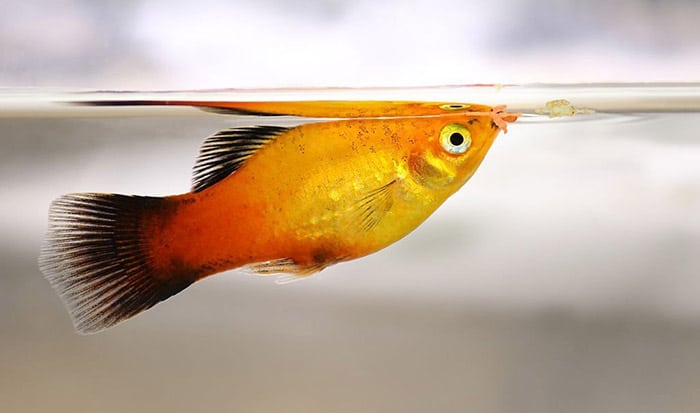
Before introducing your Platy fish to the tank, you’ll need to acclimate them first. This is a process of slowly adjusting them to the temperature, pH, and hardness of your tank water.
- To do this, float the sealed bag containing your Platy fish in the tank for about 15 minutes. This will allow the Platy fish to get used to the water temperature.
- After 15 minutes, open the bag and add a small amount of tank water to it. Close the bag and let it float for another 15 minutes. Repeat this process until the bag is full of tank water. This will usually take about an hour.
- Once your Platy fish have had a chance to acclimate, you can introduce them to the tank. Start by adding just a few fish at a time so they can get used to their new surroundings.
- Feed them immediately after adding them to the tank. This will help reduce stress and make them feel more comfortable in their new home.
How to transfer Platy Fish
If you want to move your Platy fish to a new home, there are a few things you need to do first.
First, you’ll need to acclimate your fish to the new environment.
This means slowly changing the temperature and hardness of the water so that it’s similar to their current home. You can do this by adding a small amount of the new water to their tank each day.
Once the water is acclimated, you can begin the transfer process.
The best way to do this is to use a small net or cup to catch each individual fish and then place them in a clean bucket with air holes. Be sure to fill the bucket with enough water so that the fish have plenty of room to swim.
Now it’s time to move the fish to their new home.
Slowly pour the water from the bucket into their new tank, being careful not to pour too quickly and shock the fish. Once all the fish are in their new tank, you can discard the old water and set up their new home according to their needs.
What do Platy Fish eat?
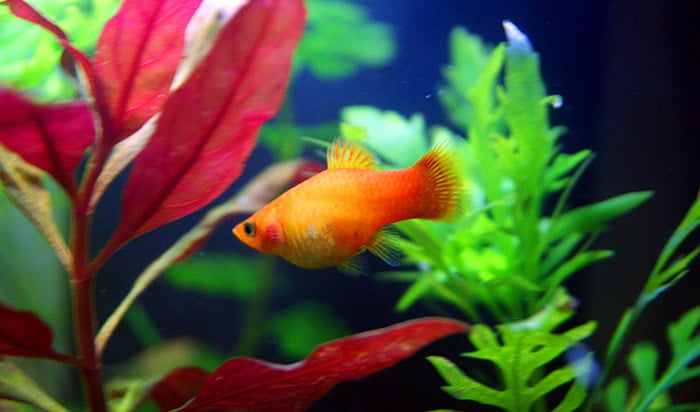
Platy fish are a popular choice for many aquarium enthusiasts due to their bright colors and playful personalities. While they are relatively easy to care for, it’s important to understand what
Platy fish eat to keep them healthy and happy.
In the wild, Platy fish are omnivores that feed on a variety of small aquatic creatures, plant matter, and algae. In captivity, they should be fed a diet that replicates their natural diet as closely as possible. This means offering them a variety of foods, including live or frozen foods, pellets or flakes, and vegetables.
- Live and frozen foods are an excellent source of nutrition for Platy fish and should be offered frequently.
- Live foods such as brine shrimp, daphnia, and bloodworms are all good choices. Frozen foods like krill, Mysis shrimp, and plankton are also excellent options.
- Pellets and flakes are a more convenient option for many aquarium owners, and there are many good-quality products available that will provide Platy fish with the nutrition they need.
However, it’s important to supplement these dry foods with fresh or frozen foods to ensure that your Platy fish are getting a well-rounded diet.
Vegetables should also be a part of platy fish’s diet. While they may not eat as much of them as they do other foods, vegetables offer essential vitamins and minerals that Platy fish need to stay healthy. Blanching or steaming vegetables before adding them to the aquarium will make them more palatable for Platy fish.
By offering a variety of foods, you can ensure that your Platy fish are getting the nutrition they need to stay healthy and thrive.
How to Feed a Platy Fish
Platy fish are a type of freshwater fish that are popular among aquarium enthusiasts. They are relatively easy to care for and can be a great addition to any tank. When it comes to feeding your platyfish, there are a few things you need to keep in mind.
- First, their diet should consist mostly of plant matter. There are a variety of commercial foods available that are specifically designed for platies and other herbivorous fish. You can also offer them live or frozen foods such as brine shrimp, daphnia, or bloodworms.
- Second, you need to be aware of the fact that platies have a very high metabolism. This means that they need to eat small meals several times a day. A good rule of thumb is to feed them twice a day in small amounts that can be easily consumed.
- Finally, it is important to remove any uneaten food from the tank after a meal. This will help keep the water clean and prevent pollution.
How Much to Feed Your Platy Fish
Your platy fish needs to be fed a nutritious diet to stay healthy and happy. But how much food does your platy fish need, and how often should you feed them?
As a general rule of thumb, you should feed your platy fish twice a day, giving them as much food as they can eat in 2-3 minutes. It’s also important to offer a variety of different foods, as this will help ensure that your platy gets all the nutrients they need.
In terms of specific amounts, a good starting point is to give your platy 1-2 pellets or flakes per meal. If you’re feeding live or frozen foods, then 3-4 small pieces per meal should be sufficient.
Of course, every platy is different and you may need to adjust the amount of food you’re offering based on your particular fish’s appetite.
If you notice that your platy is looking a little plump, then cut back on the amount of food you’re giving them. Conversely, if your platy seems to be losing weight, then you may need to increase the amount of food you’re feeding them.
How often to change Platy Fish water
While platies are generally low-maintenance, one important aspect of their care is water quality. Platies are very sensitive to ammonia and nitrites, so it’s crucial to keep the water in their tank clean and well-filtered.
The frequency with which you need to change the water in a platy tank depends on a few factors. The size of the tank, the number of fish, and the filtration system all play a role.
If you have a larger tank or a heavier bioload (more fish), you may need to change the water more frequently. It’s always better to err on the side of caution when it comes to water changes.
It is generally recommended to change the water in a Platy fish tank every week. This helps to keep the water clean and fresh and prevents the build-up of harmful toxins.
If you are using a gravel filter, then you may only need to change the water every two weeks.
However, if you notice that the water is starting to look dirty or cloudy, then you should change it as soon as possible.
Always remember to use clean, fresh water when changing the water in your Platy fish tank.
Common Platy Fish Diseases
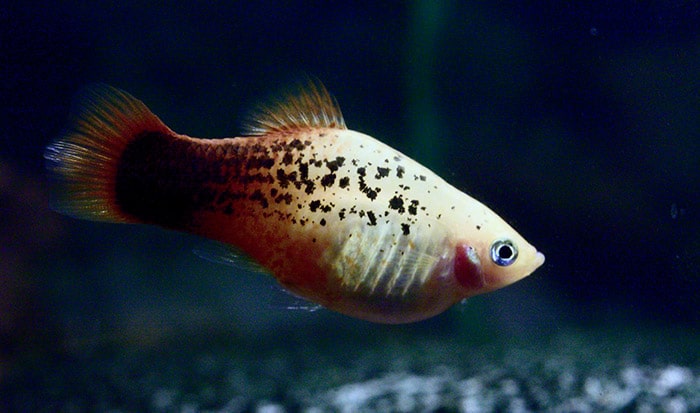
Just like any other pet, platyfish are susceptible to a variety of diseases. Some of the most common diseases that affect platies include:
Swim bladder disease
Swim bladder disease is a common ailment in platies and is caused by a variety of factors, including constipation, infection, or injury. Symptoms include buoyancy issues (platies may float at the surface or sink to the bottom), loss of appetite, and lethargy.
Bacterial infections
Bacterial infections are another common type of disease in platies and can be caused by contaminated water, food, or plants. Symptoms include cloudy eyes, white spots on the body, redness or inflammation, loss of appetite, and lethargy.
Parasites
Symptoms of parasites include itching, scratching, redness or inflammation, loss of appetite, and lethargy. If left untreated, parasites can cause serious health problems and even death.
Fungal infections
Fungal infections are often caused by contaminated water or plants. Symptoms include white patches on the body, finrot, and lethargy. To treat this disease, it’s important to add antibiotics, aquarium salt, and formalin to the fish tank and change the water after 3 – 4 days after one dose.
Viruses
Viruses are the least common type of disease in platies but can still be a problem. They are often spread through contaminated water or food. Symptoms include cloudy eyes, white spots on the body, redness or inflammation, loss of appetite, and lethargy.
How do you breed Platy Fish
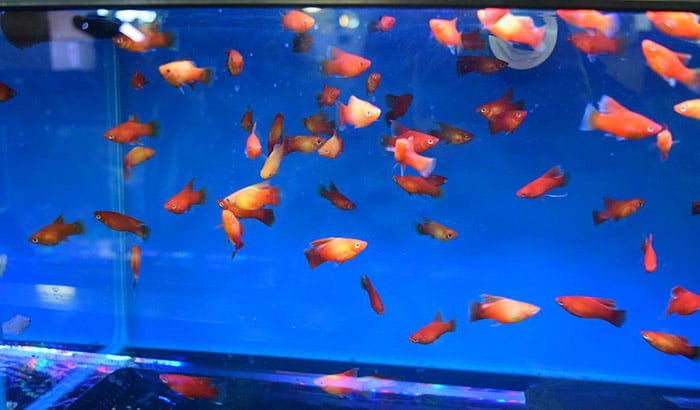
Platy fish are a type of freshwater fish that are popular among aquarium enthusiasts. They are known for their vibrant colors and playful personalities. Platies are livebearers, meaning they give birth to live young rather than laying eggs.
If you’re interested in breeding platies, there are a few things you’ll need to do in order to ensure success.
First, you’ll need to purchase a group of platies that includes both males and females. It’s best to have at least three or four fish of each sex to promote healthy breeding.
You’ll also need to provide your platies with an aquarium that is spacious and has plenty of hiding places. Aquatic plants can help create a natural environment for the fish and also provide hiding spots for the fry (baby fish) once they are born.
When it comes to breeding, platies are generally pretty easygoing. The males will chase after the females, and the two will ‘tangle’ fins in order to mate.
Once mating has occurred, the female will store the sperm inside her body and can use it to fertilize eggs over a period of several weeks. During this time, you may notice that the female’s belly begins to swell as she grows full of eggs.
Within a month or so, the female will give birth to live young. She can produce anywhere from 10 to 60 fry at a time! The fry is very small and vulnerable when they are first born, so it’s important to provide them with plenty of hiding places in the aquarium.
Aquatic plants can again be very helpful in this regard. The fry will grow quickly and should be large enough to eat regular fish food within a few weeks.
How do Platy Fish mate
Platy fish mate by a process called spawning? The female Platy fish will release her eggs into the water, and the male Platy fish will then fertilize them. The eggs will float to the top of the water, where they will hatch into fry (baby fish). The fry will then grow and mature into adult Platy fish.
It is easy to tell when a Platy fish is about to spawn because she will become very plump, and her belly will be full of eggs. When she is ready, she will swim to the surface of the water and release her eggs. The male Platy fish will then swim over and fertilize them. The eggs will sink to the bottom of the tank, where they will hatch into fry.
The fry will grow quickly and will be ready to mate in about 6-8 weeks. At this time, they will be about 1/2 inch long.
Common Questions About Platies
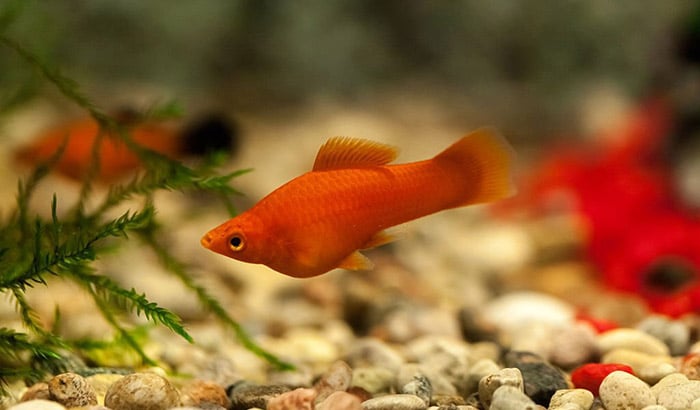
Are platies good for beginners?
Yes, platies are an excellent choice for beginner aquarium hobbyists. They are relatively easy to care for, and they are very forgiving of poor water conditions.
Do platies need a filter?
While platies can live in an unfiltered tank, it’s not recommended. A filter will help to keep the water clean, and it will also provide a place for the fish to hide.
Can platies be kept with other fish?
Yes, platies can be kept with a wide variety of other aquarium fish. Some good tank mates for platies include mollies, guppies, swordtails, and tetras.
Do platies need live food?
Platies are not obligate carnivores, which means that they do not require live food to survive. However, they will benefit from the occasional feeding of live foods, such as brine shrimp or bloodworms.
How often should I feed my platies?
Platies should be fed 2-3 times per day. They should be given enough food to eat in a minute or two. Any uneaten food should be removed from the tank.
Are platies easy to breed?
Yes, platies are very easy to breed in the aquarium. They are live-bearing fish, which means that they give birth to live young. The fry will be able to fend for themselves, and they will quickly mature into adults.
Do platies have any special care requirements?
Platies are relatively easy to care for, and they do not have any special care requirements. However, it’s important to provide them with a varied diet and to keep the tank clean.
Conclusion
Platies are a great choice for beginner aquarium hobbyists. They are relatively easy to care for, and they are very forgiving of poor water conditions. Platies are also live-bearing fish, which means that they give birth to live young. The fry will be able to fend for themselves, and they will quickly mature into adults.




